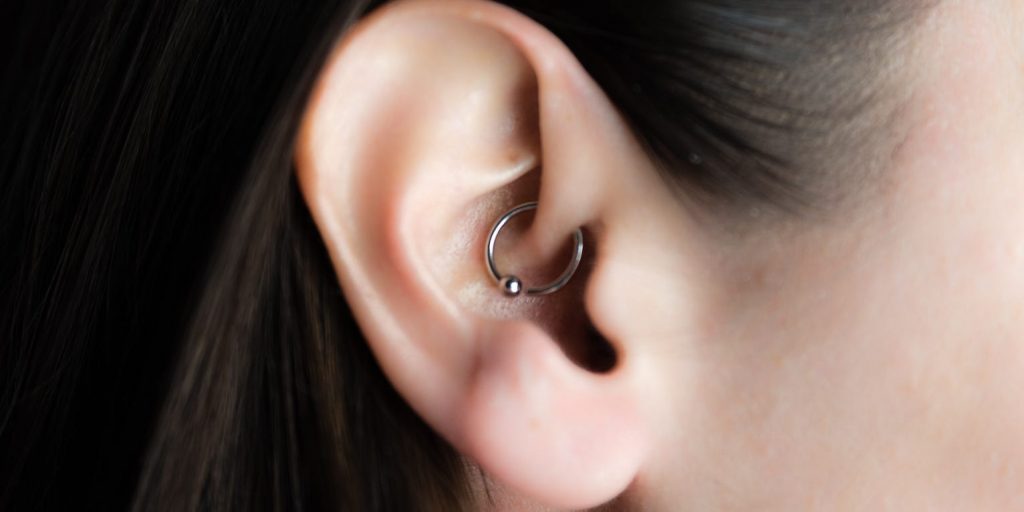- If you're looking to get a daith piercing, you can expect to spend about $30 to $80.
- It should be mild to moderately painful and you will feel the sensation of the area being squeezed.
- Though some people claim that daith piercings help migraines, there isn't enough supporting evidence.
- Visit Insider's Health Reference library for more advice.
A daith piercing is a type of ear piercing in the cartilage that sits just above your ear canal. Because it goes through hard cartilage, a daith piercing can be painful and may take a long time to heal.
Here's what a daith piercing feels like and how you should take care of it.
What is a daith piercing?
A daith piercing can be a difficult ear piercing to take care of and there are some key facts you should know before getting the procedure.
- Price: Depending on where you get pierced, daith piercings can range from $30 to $80.
- Healing time: Cartilage piercings can take six to 12 months to heal, says Starr Ellis, owner of Nine Moons Piercing and member of the Association of Professional Piercers (APP). "It is recommended to have periodic check ups with your piercer to ensure optimal healing," Ellis says.
- Pain level: On a pain scale from one to 10, daith piercings tend to range from 3 to 7, depending on your anatomy and pain tolerance, Ellis says. "Most describe the sensation as being squeezed tightly but no sharp or burning pain like other piercings," says Shorty, owner of Shorty's Fine Jewelry and Piercing and member of the APP.
- Materials: When you get any new piercing, your best options for jewelry are hypoallergenic metals or glass. The APP recommends several types of metal, including titanium, gold, or surgical steel. You should also look for jewelry that has a long post, so there's extra room for your ear to swell during healing.
How to care for a daith piercing
Once you have your daith piercing, there are some vital steps you should follow to help it heal and avoid complications like an infection.
1. Clean it every day
To keep a new daith piercing clean, you should aim to clean it three times a day for about six months. Ellis recommends following this routine:
- Wash your hands thoroughly before touching the jewelry or the skin around your piercing.
- Thoroughly rinse the area with clean, warm, running water. "This will be great for healing, irrigation, soothing, and promoting circulation," Ellis says.
- Spray a sterile saline solution on the piercing. Make sure you use a solution that's labeled as a wound wash. You can find this at most pharmacies.
- "Avoid harsh cleansers; anti-bacterial, anti-microbial, and antiseptic cleansers," Shorty says. These are not necessary and can create complications like irritation.
- Gently pat the piercing dry with a clean paper towel or gauze. "Make sure you dry the inner ear well," Shorty says, as too much moisture may lead to irritation or infection.
2. Wait a few months to change your jewelry
"Under ideal healing circumstances, a daith piercing could be changed around six to nine months of healing," Ellis says. Many people need help removing and installing jewelry in this area, so don't hesitate to reach out to a piercer for help, says Ellis.
You may be ready to change your daith jewelry if:
- It doesn't feel sore at all.
- The skin right around your piercing looks just like the other skin nearby — meaning no redness or swelling.
- There is no liquid discharge or crust coming from the piercing.
3. Don't touch or put pressure on the piercing
To help a daith piercing heal properly, you should avoid touching, squishing, or sleeping on the piercing as much as possible. If you sleep on your side, "you can try to nestle the newly pierced ear inside a donut-shaped or neck pillow to avoid any pressure," Ellis says.
Because the daith is so close to your ear canal, you should also avoid putting anything inside your ear, including earbuds, during the healing process. This can help you avoid issues like irritation bumps and infection, Ellis says.
Side effects of a daith piercing
In the first few days after getting a daith piercing, you may have a few common side effects, including:
- Soreness
- Swelling
- Bruising
- Bleeding
"Occasionally I've had clients say they got a headache on the day of the piercing. Usually it goes away within 24 hours," Shorty says.
After the initial side effects start to fade, your piercing may feel itchy and you might see whitish-yellow fluid draining or forming a crust on the daith area. This is normal, and there's no need to get medical attention.
There are a few concerning symptoms to look out for that may signal an infection:
- Severe pain, redness, or swelling
- Red streaks extending from the piercing site
- Draining large amounts of yellow or green pus
- Your symptoms are getting worse after a week
If you have any of these symptoms, get in touch with a doctor or your piercer as soon as possible.
Insider's takeaway
A daith piercing may be painful and can take several months to fully heal. Cleaning and taking care of your piercing can help it heal properly and prevent complications like infection.
For best results, "seek an experienced, well-trained professional who is knowledgeable on current industry standards," Shorty says.
The APP member locator can help you find piercers who meet the highest standards — you can search for someone in your area on their website.
